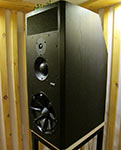| Author
|
Tuning/EQing every single bass note separately...?
|
-=Mandari=-
Mandari

Started Topics :
28
Posts :
655
Posted : Oct 18, 2013 08:41
|
|
Pythagoraz Denmark
Started Topics :
0
Posts :
1
Posted : Oct 18, 2013 19:35
|
Quote:
|
On 2013-10-09 22:51:40, golem wrote:
I have difficulties in making some of my basslines sound good and I have a theory of the reason.
- If you make 145bpm music like I do and have 1/16th long bass notes, max length for a bass note is 103ms.
- lets say that pretty basic bass note is 50hz, this means that one wave cycle takes 20ms.
- lets assume that lowest fundamental you have to deal with is 35hz, which correspond to 29ms cycle time.
- lets say that filter/opening takes 50% of time, then you have max 51.5ms left for the tale of the bass note, you cannot have enough bass cycles for your ear to create accurate pitch perception. Especially if you make the note shorter.
- you notice that if your bassline is "out of pitch" you get it back to pitch by reducing BPM of your song, which I think that proves my theory.
Big question is what you can do about it..?
I thought about trying to divide my bassline for as many tracks as there are notes and tune each note separately, do you think this is a good or bad idea..?
|
|
You should probably just ignore the theory and listen to how the track sounds as a whole. If you feel, the bass works well with the rest of your track, then it's fine. No one is going to measure the excact pitch and get angry at you for not being 100% accurate - and Kick/bass tweaking is an evil death spiral of pain and sorrow if you get too caught up in it. |

|
|
Hypereal

Started Topics :
5
Posts :
86
Posted : Oct 19, 2013 13:38
|
Bass Secrets - Mixing Bass 2
Practical E.qing - in the Context of Kick and/or Bass lines
First the bad news: there is no recipe for how to e.q a bassline. One cannot just say, "just boost x frequency by x db, or cut y frequency by x db and it'll sound great."
Why? Because it depends on the unique properties the kick you're using (mainly it's frequency content and length), the bassline note lengths, the key of the bass line, the bass sound and waveform and the bass level relative to the kick.
You have to listen to see how they interact against each other. This makes it an art rather than a science. Hence the importance of being able to actually hear what you are doing. Once you can hear what's going on, then you can begin the process of training your ears to focus upon hearing low frequency detail and start improve your mixing skill.
Second thing to bear in mind is this: If you want to have a huge and chunky bottom end on you tracks then you must either (and somewhat counter-intuitively) skinny up the bassline or the kick by reducing or removing the subs with e.q. It's either one or the other, but not both.
Both kick and bassline cannot be rich in sub-bass and co-exist in the same track at the same time. Or rather they can, but you'll end up with a boomy and indistinct result. I've known this in theory for longer than I care to admit, but that didn't stop me for most of my record making life from trying to have both the the bassline and the kick be fat and chunky at the same time, but I've eventually been dragged kicking and screaming to the conclusion that it just doesn't work.
What I've discovered by my own experimentation is that the lower you go in terms of frequency, the more problematic getting two low frequencies to co-exist becomes, to the point where, for practical purposes, only one low frequency can exist at any one time. It's a two cats in a sack situation or like two heavyweight boxers, they both cannot exist in the same ring at the same time and both be champion, there's always a fight and it's often ugly.
E.Q filters for Kick and Bass
I'm assuming that you know the difference between e.q types such as low pass, high pass etc. If not then a quick Google should bring you up to speed.
Bass shelving filter:
Bass shelves in today's plugins can often be unneccesarily complex and confusing offering several different design types ( Bessel, Gurzon, Butterworth etc.) as well as variable Q and variable filter "corner" (cutoff point).
Personally I find this counter productive.
It takes hours of practical experience with a particular e.q. shelf to become aquainted with how it affects different sounds. As an example, back in the day when I used to mix through an analogue console, I found that by using the simple 80 hz low shelf combined with the 18db/oct high pass switch and the semi-parametric low mid control which swept down to 50 hz I could find huge amount of low end shaping possibilities.
Having limitations often helps the one's creativity and ironically, infinite possibilities can actually be a hindrance by aggravating option anxiety as well as the sheer amount of time wasted by auditioning and experimenting with different filter types on each new plug-in.
(btw Bagginz Law bears repeating here. Bagginz Law states that: "The quantity of finished work leaving a producers studio is inversely proportional to the amount of plugins in that producer's plugin folder").
Given this situation, when it comes to learning how to use low shelving e.q, a good approach (and one that I often use) is to leave the Q at default, and set the frequency at 100 hz (if it's not already at 100 hz by default) and simply use the cut and boost control. Also stick to using a plugin that you're familiar working with. Later you can gradually start to use the other controls once you build up a working relationship with how it sounds and what it does.
I find bass shelves really useful to raise or lower the amount of low frequencies by varying amounts. I often end up with small cuts or boosts around < 3db, which is usually a lot if you are affecting that large a range of frequencies.
High Pass (or low cut)
High pass filters are useful for removing low frequencies altogether, rather than just reducing them.
In this context, setting a steep high pass (24db/oct or more) on a bassline channel set very low - around 20 - 35 hz can help to remove subsonics that are otherwise just eating up headroom.
Before you say "but my monitors only go down to 40hz" try it and listen. ( pro monitors quote their low frequency limit as the -3db down point, so they actually do reproduce frequencies below that.)
The effect of filtering out the ultra low subs is actually perceivable and depending on what type of filter and how steep the slope the effect, the result can be really quite pronounced.
Removing some ultra low frequencies which are mainly below the range of the monitors perversely can actually make the volume rise on the channel meters. I'm not exactly why it happens technically, but believe that it has to do with low frequency masking or phase cancelling effects.
Certainly when combining a nice kick together with the bassline channel which has had the ultra low frequencies removed, the end result is two parts tending to lock together a lot better as it minimizes the sub frequencies in each part "fighting" with each other usually by part phase-cancelling each other out. Therefore allowing the kick's subs to breathe.
Bottom line is: removing the unwanted subs from the bassline give more headroom and allows the subs in the kick sound unrestrictedly. You may want to combine this sub cut with a low shelf to reduce the low end a little - again it depends on the sound.
You can of course do it the other way around, by skinnying up the kick instead which I've done myself in several Trance tracks, (and which would be a better approach for say Dub music) but generally speaking I prefer to let the kick carry the sub in Trance.
Parametric Filter
Here's a good tip for how to zero in on frequencies using parametric e.q.s
1. Solo your channel
2. Dial up a large boost (say 8- 12 db) with a narrow q.
3. Now sweep around while listening to find the frequency that you would like to either cut or boost.
4. Once you've found the frequency, then either cut it by lowering the gain to a negative amount or lower the boost amount of that frequency to a smaller amount.
5. Unsolo your channel to place the sound back into it's musical context.
6. Switch the e.q out and back in again to give yourself a reality check as it's very easy to get quickly accustomed to a processed sound. Again, it's important to make any evaluations while it is in the mix, and not while it is in solo mode. Does it sound better? Or not?
On the Kick:
Here's a couple of useful tips for the e.q on the Kick.
1. A small boost with a medium q at around 4 khz will emphasise the "click" of the kick to allow it to not get buried in the mix.
2. If a kick needs some "punch" then a small boost with medium q centred around 120hz - 250hz will give some body. This frequency band gives the kick punch and drive (which often can be what's required) without adding problematic lows.
3. If a kick need some sub added or removed, use the parametric e.q. A low shelf is a bit too crude a tool for this kind of work. Using the parametric tip above, zoom exactly in on the area which needs treatment. Fairly narrow q often works best. You'll need to be precise with the low frequencies because in the dark netherworld of the sub regions, just going from 40 hz - 80 hz is a whole octave. If you find yourself having to boost the low end with a low shelf, then it maybe best to use another kick sample, unless of course you don't have anything better, in which case carry on.
On Bass lines:
With regard to e.q ing the bass line, once you have your basic kick and bassline levels set, don't be afraid to notch out some of the mids with a parametric if you think it sounds better, or you want to make some room in the midrange for other lead stuff.
Conversely don't be afraid to boost away on a parametric band (or two) if it will help give your bassline some definition and help it sit better in the mix.
It's not like the raw saw wave bass sound has to be kept natural.
Obviously you must do your e.q ing of the bassline when the the kick is playing along together with the bass.
E.q.ing the kick and bass group:
Another tip is to e.q the kick and bass group together. I haven't used this for a while but I've used this technique in the past. This can make the kick and bass sound more cohesive. I routinely route my kick and bass to a single group (a buss in Logic speak)
This enables me to apply any processing (filtering effects, e.q.ing, compress, limiting etc. ) to both at once should I so wish. Sending both kick and bass to their own group is a useful habit to get into. I recommend setting up your sequencer template with the routings already in place.
- Billy Cosmosis
|

|
|
Taisto
IsraTrance Junior Member

Started Topics :
16
Posts :
252
Posted : Oct 19, 2013 18:25
|
sorry wrong topic  lördag.. lördag..
        - - - - - - - - - -
- - - -
- -
- |

|
|
frisbeehead
IsraTrance Junior Member
Started Topics :
10
Posts :
1352
Posted : Oct 19, 2013 19:38
|
|
nice cosmosis tips! where did you get this from? I totally subscribe the group low end instruments and treat them together thing! been doing it for a while now! this guy knows his shit, to bad I tend to read stuff after I know it already! would mean a milion a few years ago! be sure to post that on the mother of all people sorrowing about their lame ass basslines mother of threads (as well, no? ok, biggest at least? never mind)cheers |

|
|
Hypereal

Started Topics :
5
Posts :
86
Posted : Oct 19, 2013 23:18
|
I found this info on his site but to see it you need to have account otherwise it wont show you.PS posted this text into mother of all basslines  cheers cheers |

|
|
moleqlarsuperstructure
IsraTrance Junior Member

Started Topics :
36
Posts :
265
Posted : Nov 13, 2013 23:36
|
Hey Golem. i was dealing the same for years. exact the same thing u describe. now im in a projekt studio for a few weeks with new acoustics. and i fucking dont have any difference in the bass power. sometimes a little but make soundchek 50 cm back and all sounds fat....
i made like 20 tracks with this technique.... |

|
|
golem
IsraTrance Full Member

Started Topics :
109
Posts :
70
Posted : Nov 14, 2013 00:50
|
I thought too that it is the room. Maybe it is part of the problem, it is not acoustically processed.
But if it were the rooms fault then I should hear all bass notes in tune when listening from headphones, shouldn't I?
Anyway I hear the same thing even with headphones so it cannot be caused by room acoustics.
       
http://www.soundcloud.com/dreaml4nd
http://www.mixcloud.com/aegonox-peter-pan |

|
|
PoM
IsraTrance Full Member

Started Topics :
162
Posts :
8087
Posted : Nov 14, 2013 01:13
|
|
freq where you put the filter and synth patch could maybe give a "illusion" of slight different pitchs |

|
|
daark
IsraTrance Full Member

Started Topics :
58
Posts :
1397
Posted : Nov 14, 2013 17:04
|
|
daark
IsraTrance Full Member

Started Topics :
58
Posts :
1397
Posted : Nov 14, 2013 17:06
|
so you better set your patch for at least 2 octaves or sample it down and get the best algorithm for pitchshifting the notes. don't know maybe use the best sampler so you can switch octaves without it being grainy 
        http://soundcloud.com/magimix-1/chilling-forest-whispers http://soundcloud.com/magimix-1/chilling-forest-whispers
Wierd shit happens :) |

|
|
daark
IsraTrance Full Member

Started Topics :
58
Posts :
1397
Posted : Nov 14, 2013 17:07
|
|
xoC
Cubic Spline

Started Topics :
10
Posts :
179
Posted : Nov 20, 2013 15:03
|
Quote:
|
On 2013-11-14 00:50, golem wrote:
I thought too that it is the room. Maybe it is part of the problem, it is not acoustically processed.
But if it were the rooms fault then I should hear all bass notes in tune when listening from headphones, shouldn't I?
Anyway I hear the same thing even with headphones so it cannot be caused by room acoustics.
|
|
Yes. Room can distort pitch perception, but there is also other things to consider :
Sometimes, especially with very short filter decays, the bassline can sound like it's one semitone lower than the real note, but take it one or two octaves above and the note sounds right.
I think it's the ear/brain who has difficulties in identifying pitch for very low frequencies : with a very very short filter decay, there is not enough harmonic content to allow the brain to identify correctly the note. Take the bassline one or two octaves higher, the brain is more acurate there in identifying the fundamental alone, so even if the filter decay is short, the brain process it right and the perceived pitch is correct.
So if it bothers you, try a more longer decay/opened filter.
        http://www.storm-mastering.com http://www.storm-mastering.com |

|
|
frisbeehead
IsraTrance Junior Member
Started Topics :
10
Posts :
1352
Posted : Nov 20, 2013 15:45
|
Quote:
|
On 2013-11-20 15:03, xoC wrote:
Quote:
|
On 2013-11-14 00:50, golem wrote:
I thought too that it is the room. Maybe it is part of the problem, it is not acoustically processed.
But if it were the rooms fault then I should hear all bass notes in tune when listening from headphones, shouldn't I?
Anyway I hear the same thing even with headphones so it cannot be caused by room acoustics.
|
|
Yes. Room can distort pitch perception, but there is also other things to consider :
Sometimes, especially with very short filter decays, the bassline can sound like it's one semitone lower than the real note, but take it one or two octaves above and the note sounds right.
I think it's the ear/brain who has difficulties in identifying pitch for very low frequencies : with a very very short filter decay, there is not enough harmonic content to allow the brain to identify correctly the note. Take the bassline one or two octaves higher, the brain is more acurate there in identifying the fundamental alone, so even if the filter decay is short, the brain process it right and the perceived pitch is correct.
So if it bothers you, try a more longer decay/opened filter.
|
|
yep, that's the whole deal with bass. but it pays of to actually learn what the lower frequencies are doing. but any track lacking in there will hardly feel solid or have enough weigth and depth.
if you have your filter open, then our brains pick up a perfect tone even on C0 or lower. much lower then that and most synthesizers will create just a grainy tone, that's hardly perceivable as a tone, yes. |

|
|
|